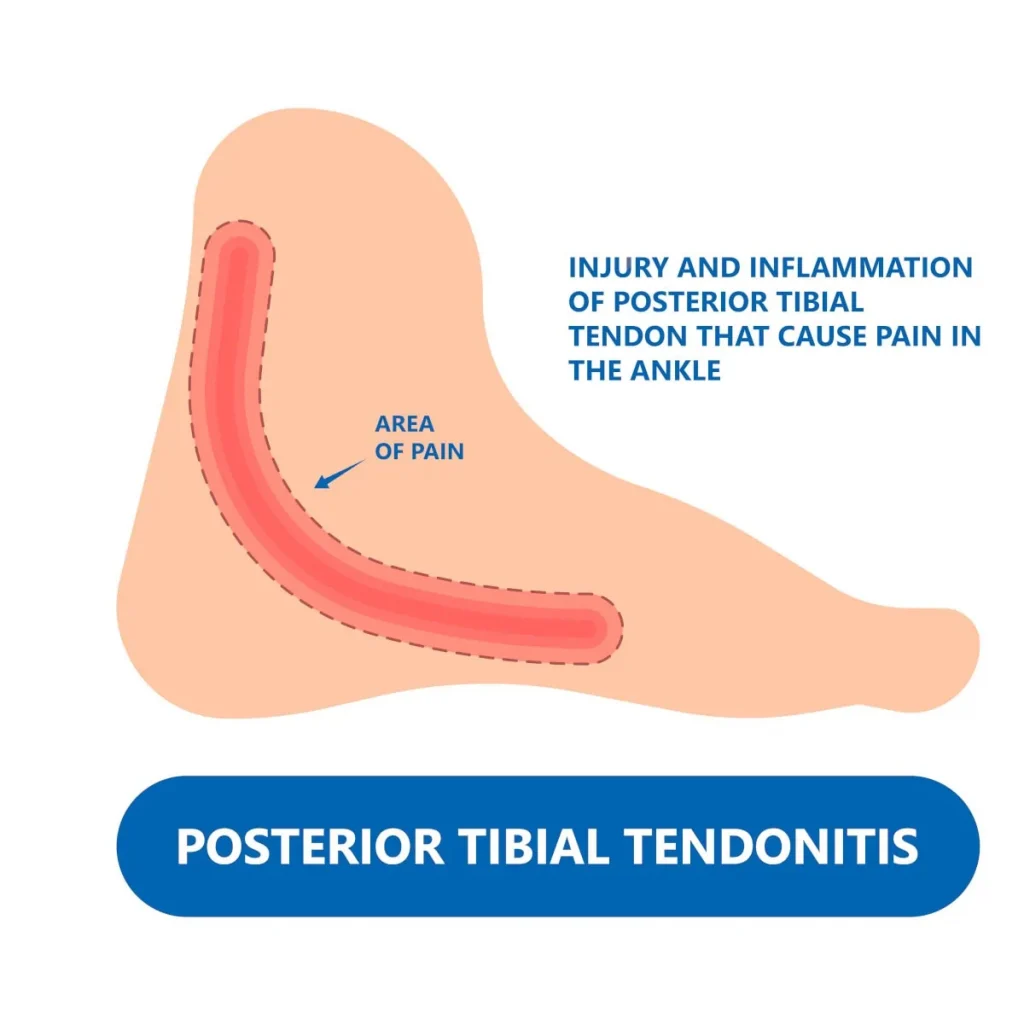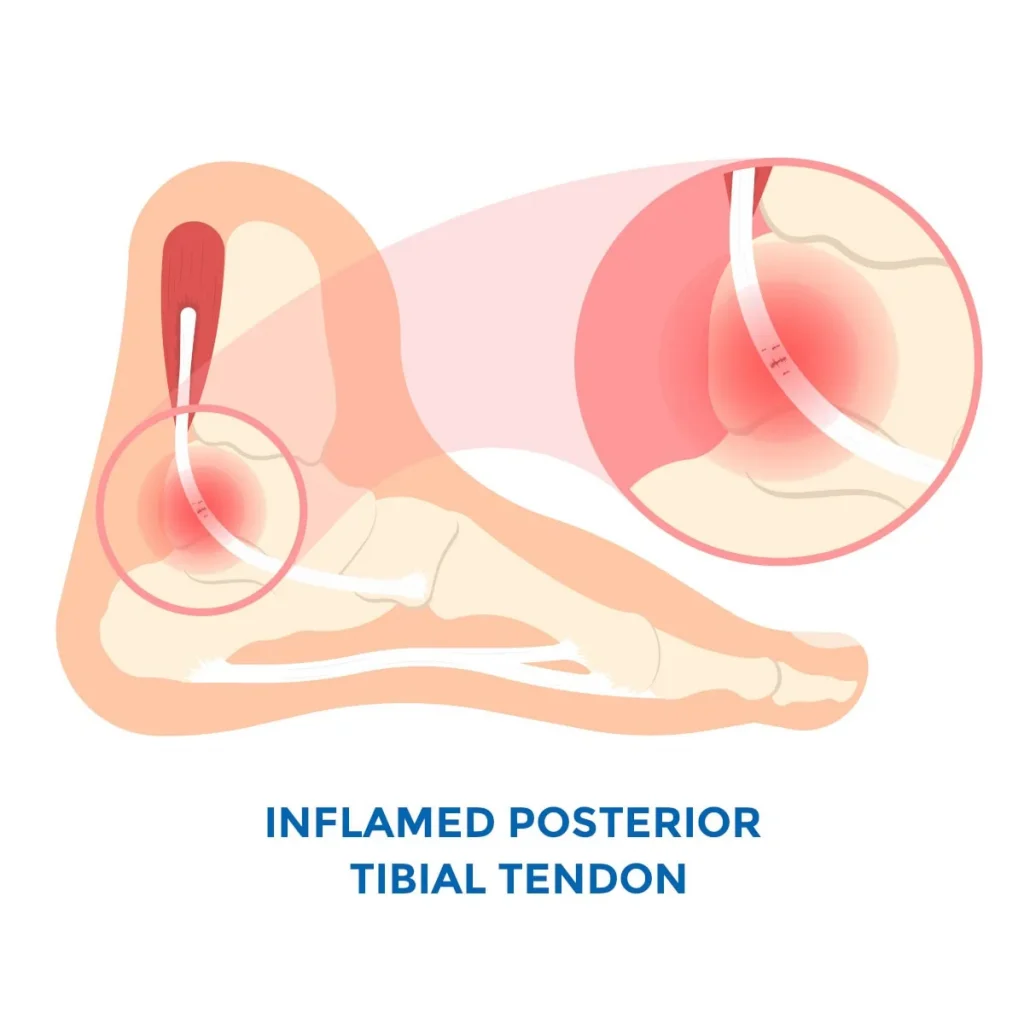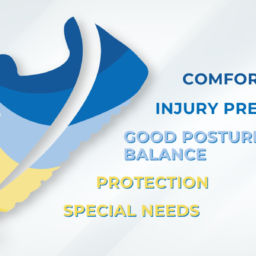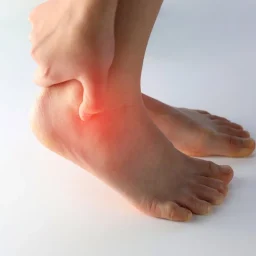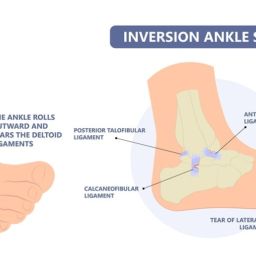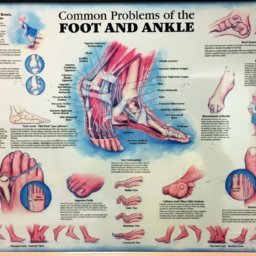
Podiatrists at Certified Foot and Ankle Specialists frequently encounter patients struggling with inner ankle pain. This discomfort along the inside of your ankle joint can significantly impact your daily activities and quality of life. Understanding the underlying causes and available treatment options is essential for achieving lasting relief.
What Causes Inner Ankle Pain?
Inner ankle pain typically stems from problems affecting the structures on the medial (inside) side of the ankle. The most common culprit is posterior tibial tendonitis, a condition that affects the tendon responsible for supporting the arch of your foot.
Posterior Tibial Tendonitis
The posterior tibial tendon connects your calf muscle to the bones in your foot, playing a crucial role in maintaining your arch and providing stability during walking. When this tendon becomes inflamed or damaged, it results in pain along the inner ankle and instep area.
Common symptoms include:
- Gradual onset of pain on the inside of your ankle
- Swelling along the tendon pathway
- Difficulty with push-off during walking
- Progressive flattening of the arch
- Pain that worsens with physical activity
Fallen Arch and Flat Feet
A fallen arch, often associated with posterior tibial tendon dysfunction, can cause significant pain. This condition develops when the tendon can no longer adequately support the arch, leading to structural changes in your foot and ankle alignment.
Patients with flat feet are particularly susceptible to developing pain due to the increased stress placed on the posterior tibial tendon and surrounding structures of the inner ankle.
Risk Factors for Inner Ankle Pain
Several factors can increase your likelihood of pain developing:
Anatomical Factors:
- Flat feet or fallen arches
- Previous ankle sprain injuries
- Abnormal foot mechanics
Activity-Related Factors:
- Sudden increase in physical activity
- Repetitive stress from running or jumping
- Participation in sports requiring quick directional changes
Medical Conditions:
- Diabetes, which can affect tendon health
- Inflammatory conditions like rheumatoid arthritis
- Obesity, which increases stress on foot structures
Diagnosis and Evaluation
At Certified Foot and Ankle Specialists, our comprehensive evaluation begins with a detailed examination of your foot and ankle structure. We assess your arch height, tendon integrity, and overall biomechanics to identify the source of your ankle pain.
Diagnostic imaging may include X-rays to evaluate bone alignment and MRI studies to visualize soft tissue structures like the posterior tibial tendon. This thorough approach ensures accurate diagnosis and appropriate treatment planning.
Treatment Options for Inner Ankle Pain
Conservative Nonsurgical Treatment
Most cases respond well to conservative management:
Rest and Activity Modification: Reducing activities that aggravate symptoms allows inflamed tissues to heal. This doesn’t mean complete inactivity, but rather avoiding high-impact activities that stress the affected structures.
Rest Ice Therapy: Apply ice for 15-20 minutes several times daily to reduce inflammation and pain. Always use a barrier between ice and skin to prevent injury.
Anti Inflammatory Medications: Over-the-counter NSAIDs can help manage pain and reduce inflammation. However, these should be used under medical supervision, especially for extended periods.
Supportive Footwear: Proper shoes with good arch support can help reduce stress on the posterior tibial tendon. Custom orthotics may be recommended to provide additional support and correct biomechanical abnormalities.
Physical Therapy and Strengthening Exercises
Physical therapy plays a crucial role in treatment. A structured program typically includes:
- Gentle stretching exercises to improve flexibility
- Strengthening exercises targeting the posterior tibial tendon and surrounding muscles
- Balance training to improve stability
- Gait analysis and correction techniques
These interventions help restore normal function while preventing future episodes of pain.
Advanced Treatment Options
For persistent or severe cases that don’t respond to conservative treatment, additional options may be considered:
Immobilization: A walking boot or cast may be necessary to allow severely inflamed tendons to heal properly.
Injection Therapy: Corticosteroid injections can provide temporary relief for severe inflammation, though this treatment requires careful evaluation due to potential risks.
Surgical Intervention: In cases of complete tendon rupture or severe dysfunction, surgical repair or reconstruction may be necessary to restore function and alleviate pain.
Prevention Strategies
Preventing inner ankle pain involves several key approaches:
Proper Footwear: Choose shoes with adequate arch support and cushioning. Replace worn athletic shoes regularly to maintain proper support.
Gradual Activity Progression: When starting new physical activities or increasing intensity, progress gradually to allow your tendons and muscles to adapt.
Maintain Healthy Weight: Excess weight increases stress on foot and ankle structures, contributing to tendon problems.
Address Flat Feet: If you have flat feet, consider custom orthotics or supportive devices to reduce stress on the posterior tibial tendon.
When to Seek Professional Care For Inner Ankle Pain
While mild pain in the area may respond to home treatment, certain symptoms warrant immediate professional evaluation:
- Severe pain that limits walking or daily activities
- Sudden onset of intense pain following injury
- Visible deformity or significant swelling
- Symptoms that persist despite conservative treatment
- Signs of infection, such as warmth, redness, or fever
Recovery and Long-Term Management
Recovery varies depending on the underlying cause and severity of the condition. Mild cases may resolve within a few weeks with proper treatment, while more severe conditions might require several months of rehabilitation.
Our team at Certified Foot and Ankle Specialists works closely with patients to develop personalized recovery plans. We monitor progress through follow-up appointments and adjust treatment strategies as needed to ensure optimal outcomes.
Long-term management often involves ongoing use of supportive devices, regular stretching and strengthening exercises, and periodic monitoring to prevent recurrence.
Expert Care at Certified Foot and Ankle Specialists
Understanding the complex anatomy and biomechanics involved requires specialized knowledge and experience. Our board-certified podiatrists have extensive training in diagnosing and treating posterior tibial tendonitis and related conditions.
We utilize the latest diagnostic technologies and evidence-based treatment approaches to provide comprehensive care for our patients. From conservative management to advanced surgical techniques, we offer the full spectrum of treatment options tailored to individual needs.
Don’t let pain from your inner ankle limit your activities or quality of life. If you’re experiencing persistent discomfort along the inside of your ankle, contact Certified Foot and Ankle Specialists today to schedule a consultation. Our experienced team is committed to helping you achieve optimal foot and ankle health and return to the activities you enjoy.
Early intervention often leads to better outcomes and faster recovery, so don’t delay seeking professional care when the pain persists or interferes with your daily routine. With proper diagnosis and treatment, most patients can achieve significant improvement and return to their normal activities pain-free.
Frequently Asked Questions About Inner Ankle Pain
Q. What causes inner ankle pain?
A: Inner ankle pain is commonly caused by posterior tibial tendon dysfunction, tarsal tunnel syndrome, or medial ankle sprains. Other causes include arthritis, stress fractures, or overuse injuries from activities like running or walking on uneven surfaces.
Q. What causes inner ankle pain when walking and running?
A: This condition is often due to posterior tibial tendon dysfunction, which occurs when the tendon that supports your arch becomes inflamed or torn. This condition is particularly common in runners and can also result from overpronation or wearing improper footwear.
Q. When should I see a foot and ankle specialist for inner ankle pain?
A: You should seek professional care if your inner ankle pain persists for more than a few days, is accompanied by swelling or numbness, or if you’re unable to bear weight. At Certified Foot and Ankle Specialists, our doctors can provide an accurate diagnosis and personalized treatment plan.
Q. Can the pain of the inner ankle be treated without surgery?
A: Most cases of respond well to conservative treatments, including rest, ice, compression, physical therapy, and custom orthotics. Surgery is typically only recommended when conservative treatments haven’t provided relief after several months.
Q. How long does it take to heal?
A: Recovery time varies depending on the underlying cause, but most inner ankle injuries heal within 2-6 weeks with proper treatment. More severe conditions like posterior tibial tendon dysfunction may require several months of treatment and rehabilitation.
Q.What can I do at home?
A: Initial treatment includes rest, ice application for 15-20 minutes several times daily, compression with an elastic bandage, and elevation of the foot. Over-the-counter anti-inflammatory medications can also help reduce pain and swelling.
Q. Is this common in South Florida residents?
A: Yes, this type of foot issue is frequently seen in South Florida due to our active outdoor lifestyle, beach walking on uneven sand surfaces, and year-round sports activities. The humid climate can also contribute to increased activity levels that may lead to overuse injuries.
Q. Where can I get treatment for inner ankle pain in South Florida?
A: Certified Foot and Ankle Specialists has multiple convenient locations throughout South Florida, including Fort Lauderdale, Boca Raton, West Palm Beach, Tampa, and other areas. Our board-certified specialists provide comprehensive care for all types of ankle pain and injuries.
